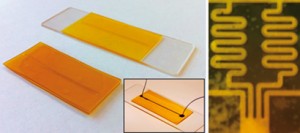
Left: macro images of zein-glass and zein-zein microfluidic devices. The inset shows a colourant-filled zein-glass microfluidic device with tubings. Right: serpentine channels for mixing two different chemical fluids
Gang Logan Liu and colleagues at the University of Illinois Urbana-Champaign, have demonstrated that by using lithography and solvent or vapour deposition bonding, thin films of zein (a protein extracted from corn by-products) can be used to construct microfluidic channels, grids and wells as a green alternative to the plastic materials currently in use.
The group tested their zein microfluidic devices using several types of fluid, including fluorescent dyes and solutions of microbeads. They found that the devices did not leak and the channels could easily be viewed through a microscope. They also extended their work to produce a concentration gradient generator, mixing dye and solvent within serpentine channels to create several different concentration mixtures.
Liu anticipates being able to use the simple bonding of the zein films to make multilayer microfluidic devices in the future.
Interested? Read Tamsin Phillips’ full Chemistry World article here or download the Lab on a Chip paper:
Green microfluidic devices made of corn proteins
Jarupat Luecha, Austin Hsiao, Serena Brodsky, Gang Logan Liu and Jozef L. Kokini
Lab Chip, 2011, Advance Article
DOI: 10.1039/C1LC20726A










